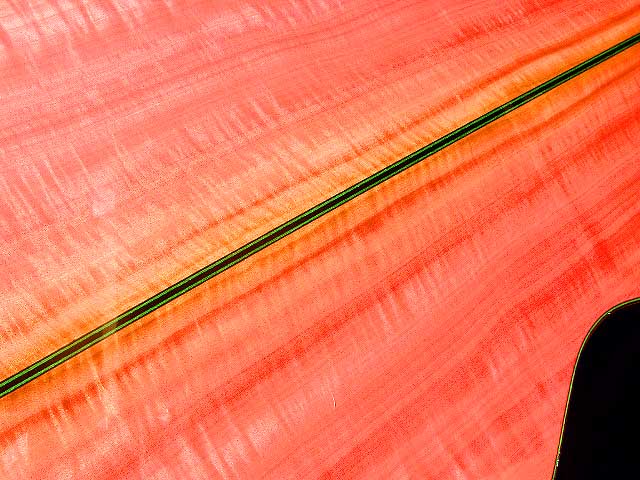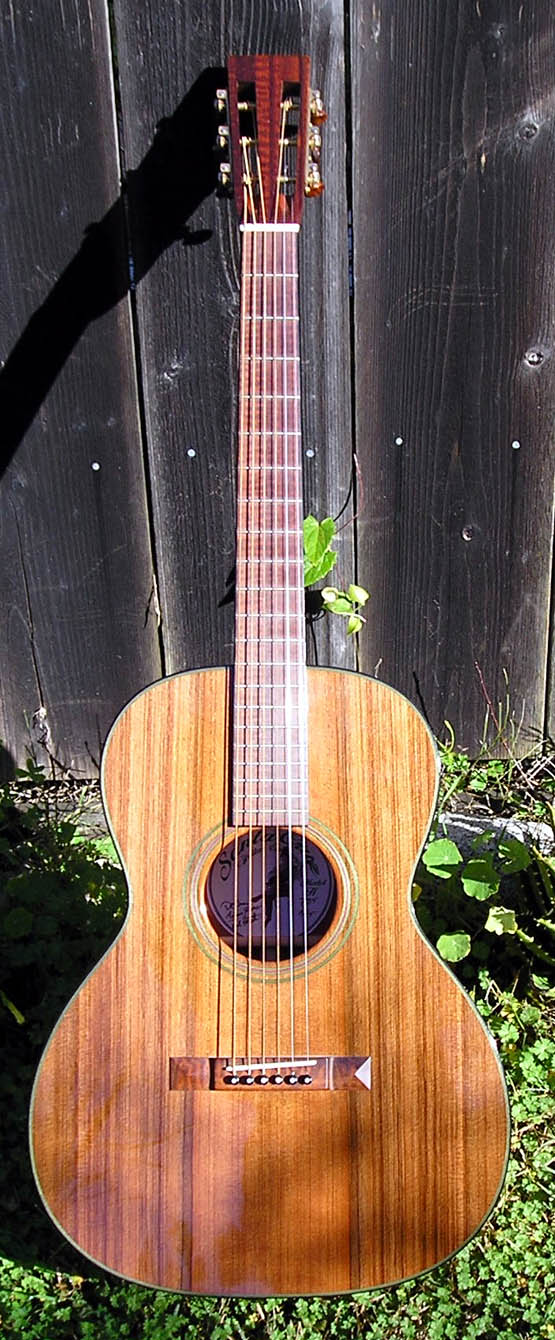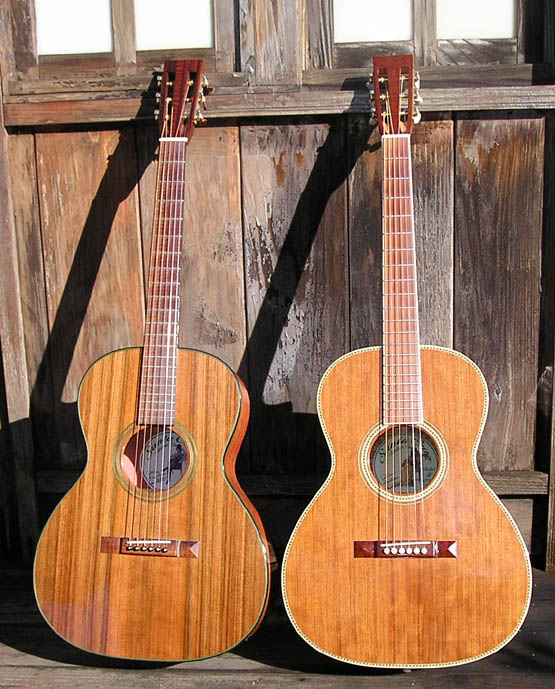
Everyone asks about the pink ivory one, so OK,
here it is. It belongs to Henry Kaiser, my longtime pal from Oakland who,
bless him, has a very adventuresome spirit about him, musically and in
most other ways.
Pink Ivory: Berchemia zeyheri, of the family
Rhamnaceae (buckthorn), also known as Umnini and Umgoloty in its native
range scattered over Mozambique, Zimbabwe and South Africa. It's very hard
and dense, and extremely rare.

The neck is padauk. The binding is black with green accents.

You can get a small sense of the green as it radiates from the redwood
top. The redwood in this one, like the redwood in mine, came from the Norris
place down Smith Grade from my house. The pieces came from different trees
however. Both were probably cut down in the 1880s. The wood was taken from
the stump, or snag as we call them hereabouts.

More pinkness! This guitar is a symphony of reds and pinks.
The story of pink ivory as I have it: it is native to a very small and
disparately scattered areas in southern Africa. The lot on the market recently
came entirely from within the boundaries of one of the tribal homelands
in the northeast of the country where the tree was strictly reserved for
harvest by the son of a chief when he ascended to become the new chief.
The tradition was: they aspirant would go into the forest and cut one of
these trees and fashion a ceremonial lance which would be his emblem of
office. This was the only condition under which anyone would even touch
this sacred tree.
Evidently, as the story continues, after the fall of apartheid the tribal
elders petitioned the government for electricity. The government determined
that hydroelectric was feasible but would involve damming a river and filling
a valley. It agreed to underwrite the project if it could harvest and sell
the trees in the valley. Hence a good number of these trees were cut and
very carefully marketed. Henry actually found this wood online at a dealer
in Oregon.

Back of the padauk headstock. Padauk is a heavy wood, like rosewood.
We used it for sides and backs of several other guitars in this series.
These are temporary gears. The real ones are below.

As you might notice, the fingerboard, overlay,
bridge and tuning machine buttons are all in snakewood.

The bridge is gorgeous.

You can see the green purfling strips in the redwood top with the line
of hot magenta setting everything off bigtime.
Henry is the only kid on the block with this label. That's yours truly,
relaxing in sock feet and wearing the uncharacteristic fez (thank you,
Allan Dodge) whilst playing a Nick Lucas in Henry's kitchen. Next thing
I knew, it was on a label inside this guitar. Yikes. Talk about mixed metaphors.
Even though it says 2/15, this was the second to last one off the line.


This one and mine were the two in the batch made with redwood tops.
Thanks to my friend and neighbor Fred Carlson, an outrageous luthier in
his own right, for this wood.

Flip 'em over and this is what you see:

These guitars sound very different, partly because the redwood
is different, and partly because the body woods are drastically different.
Sycamore is very light, lighter than mahogany. Pink ivory is way beyond
ebony. And the padauk neck on Henry's has a huge effect as well. More photos
of the sycamore guitar here.
More to look at...
To photo page
#1 :Ray Bierl Sitka+EIR | Josh Michaell
cedar+walnut | PH redwood+sycamore
#2 :Rick Chelew cedar+mahogany |
Bob Carlin sunburst sitka+mahogany
#3 :Henry Kaiser redwood+pink ivory|+PH
#4 :Kevin Carr
#5 : Chris Cooper Adirondack+bigleaf
maple
#6 : Bruce Molsky Adirondack+padauk
|
Main Model H page
My main page
 Questions?
Drop me a line:
click
here
Questions?
Drop me a line:
click
here